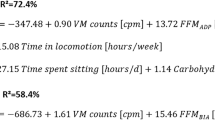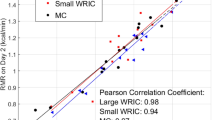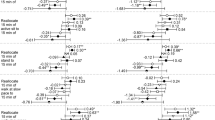Abstract
Background/Objective:
The Actiheart (Mini Mitter, Sunriver, OR, USA) uses heart rate (HR) and activity data to predict activity energy expenditure (AEE). Currently, the Actiheart has only been tested during laboratory conditions. Therefore, the objective of this study was to validate the Actiheart prediction method against indirect calorimetry during a wide range of activities in a field setting.
Subjects/Methods:
Forty-eight participants (age: 35±11.4 years) were recruited for the study. Eighteen activities were split into three routines of six activities and each routine was performed by 20 participants. During each routine, the participants wore an Actiheart and simultaneously, AEE was measured with a Cosmed K4b2 portable metabolic system. The manufacturer's HR algorithm, activity algorithm, and combined activity and HR algorithm were used to estimate AEE.
Results:
The mean error (and 95% prediction intervals) for the combined activity and HR algorithm, HR algorithm, and activity algorithm versus the Cosmed K4b2 were 0.02 kJ kg−1 min−1 (−0.17, 0.22 kJ kg−1 min−1), −0.03 kJ kg−1 min−1 (−0.24, 0.18 kJ kg−1 min−1), and 0.14 kJ kg−1 min−1 (−0.12, 0.40 kJ kg−1 min−1), respectively.
Conclusion:
The Actiheart combined activity and HR algorithm and HR algorithm provide similar estimates of AEE on both a group and individual basis.
This is a preview of subscription content, access via your institution
Access options
Subscribe to this journal
Receive 12 print issues and online access
$259.00 per year
only $21.58 per issue
Buy this article
- Purchase on Springer Link
- Instant access to full article PDF
Prices may be subject to local taxes which are calculated during checkout


Similar content being viewed by others
References
Bassett Jr DR, Ainsworth BE, Swartz AM, Strath SJ, O'Brien WL, King GA (2000). Validity of four motion sensors in measuring moderate intensity physical activity. Med Sci Sports Exerc 32, S471–S480.
Bland JM, Altman DG (1986). Statistical methods for assessing agreement between two methods of clinical measurement. Lancet North Am Ed 1, 307–310.
Brage S, Brage N, Franks PW, Ekelund U, Wareham NJ (2005). Reliability and validity of the combined heart rate and movement sensor Actiheart. Eur J Clin Nutr 59, 561–570.
Brage S, Brage N, Franks PW, Ekelund U, Wong MY, Andersen LB et al. (2004). Branched equation modeling of simultaneous accelerometry and heart rate monitoring improves estimate of directly measured physical activity energy expenditure. J Appl Physiol 96, 343–351.
Cambridge Neurotechnology Ltd (2004). The Actiheart User Manual (v. 3.04). Cambridge Neurotechnology Ltd: Cambridgeshire, United Kingdom.
Corder K, Brage S, Wareham NJ, Ekelund U (2005). Comparison of PAEE from combined and separate heart rate and movement models in children. Med Sci Sports Exerc 37, 1761–1767.
Crouter SE, Churilla JR, Bassett Jr DR (2006a). Estimating energy expenditure using accelerometers. Eur J Appl Physiol 98, 601–612.
Crouter SE, Clowers KG, Bassett Jr DR (2006b). A novel method for using accelerometer data to predict energy expenditure. J Appl Physiol 100, 1324–1331.
Freedson PS, Melanson E, Sirard J (1998). Calibration of the Computer Science and Applications, Inc. acclerometer. Med Sci Sports Exerc 30, 777–781.
Haskell WL, Yee MC, Evans A, Irby PJ (1993). Simultaneous measurement of heart rate and body motion to quantitate physical activity. Med Sci Sports Exerc 25, 109–115.
Helmrich SP, Ragland DR, Leung RW, Paffenbarger Jr RS. (1991). Physical activity and reduced occurrence of non-insulin-dependent diabetes mellitus. N Engl J Med 325, 147–152.
Hendelman D, Miller K, Baggett C, Debold E, Freedson P (2000). Validity of accelerometry for the assessment of moderate intensity physical activity in the field. Med Sci Sports Exerc 32, S442–S449.
Klippel NJ, Heil DP (2003). Validation of energy expenditure prediction algorithms in adults using the Actical electronic activity monitor. Med Sci Sports Exerc 35, S284.
Lee IM, Sesso HD, Oguma Y, Paffenbarger Jr RS. (2003). Relative intensity of physical activity and risk of coronary heart disease. Circulation 107, 1110–1116.
Lee I-M, Skerrett PJ (2001). Physical activity and all-cause mortality: what is the dose–response relation? Med Sci Sports Exerc 33, S459–S471.
Luke A, Maki KC, Barkey N, Cooper R, McGee D (1997). Simultaneous monitoring of heart rate and motion to assess energy expenditure. Med Sci Sports Exerc 29, 144–148.
Manson JE, Hu FB, Rich-Edwards JW, Colditz GA, Stampfer MJ, Willett WC et al. (1999). A prospective study of walking as compared with vigorous exercise in the prevention of coronary heart disease in women. N Engl J Med 341, 650–658.
Mini Mitter Company Inc (2004). Actiheart Instruction Manual. Mini Mitter Company, Inc.: Bend, OR.
Montoye HJ, Kemper HCG, Saris WHM, Washburn RA (1996). Measuring Physical Activity and Energy Expenditure. Human Kinetics: Champaign, IL.
Moon JK, Butte NF (1996). Combined heart rate and activity improve estimates of oxygen consumption and carbon dioxide production rates. J Appl Physiol 81, 1754–1761.
Morris JN, Clayton DG, Everitt MG, Semmence AM, Burgess EH (1990). Exercise in leisure time: coronary attack and death rates. Br Heart J 63, 325–334.
Nichols JF, Morgan CG, Chabot LE, Sallis JF, Calfas KJ (2000). Assessment of physical activity with the Computer Science and Applications, Inc., accelerometer: laboratory versus field validation. Res Q Exerc Sport 71, 36–43.
Paffenbarger RSJ, Hyde RT, Wing AL, Hsieh CC (1986). Physical activity, all-cause mortality, and longevity of college alumni. N Engl J Med 314, 605–613.
Paffenbarger RSJ, Wing AL, Hyde RT (1978). Physical activity as an index of heart attack risk in college alumni. Am J Epidemiol 108, 161–175.
Rennie K, Rowsell T, Jebb SA, Holburn D, Wareham NJ (2000). A combined heart rate and movement sensor: proof of concept and preliminary testing study. Eur J Clin Nutr 54, 409–414.
Strath SJ, Bassett Jr DR, Swartz AM, Thompson DL (2001). Simultaneous heart rate-motion sensor technique to estimate energy expenditure. Med Sci Sports Exerc 33, 2118–2123.
Strath SJ, Bassett Jr DR, Thompson DL, Swartz AM (2002). Validity of the simultaneous heart rate-motion sensor technique for measuring energy expenditure. Med Sci Sports Exerc 34, 888–894.
Strath SJ, Brage S, Ekelund U (2005). Integration of physiological and accelerometer data to improve physical activity assessment. Med Sci Sports Exerc 37, S563–S571.
Swartz AM, Strath SJ, Bassett Jr DR, O'Brien WL, King GA, Ainsworth BE (2000). Estimation of energy expenditure using CSA accelerometers at hip and wrist sites. Med Sci Sports Exerc 32, S450–S456.
Thompson D, Batterham AM, Bock S, Robson C, Stokes K (2006). Assessment of low-to-moderate intensity physical activity thermogenesis in young adults using synchronized heart rate and accelerometry with branched-equation modeling. J Nutr 136, 1037–1042.
Welk GJ, Blair SN, Wood K, Jones S, Thompson RW (2000). A comparative evaluation of three accelerometry-based physical activity monitors. Med Sci Sports Exerc 32, S489–S497.
Acknowledgements
We thank Cary Springer (UTK Statistical Consulting Services) for assisting with the statistical analyses. Mini Mitter loaned the Actiheart equipment for the duration of the study, but no financial support was provided by the company. This research was supported by the Charlie and Mai Coffey Endowment in Exercise Science. All authors were involved in planning and carrying out the subject testing. Data analysis and the first draft of the manuscript were the primary responsibility of SEC. All authors were closely involved in revisions and final approval. None of the authors had a personal or financial conflict of interest.
Author information
Authors and Affiliations
Corresponding author
Rights and permissions
About this article
Cite this article
Crouter, S., Churilla, J. & Bassett, D. Accuracy of the Actiheart for the assessment of energy expenditure in adults. Eur J Clin Nutr 62, 704–711 (2008). https://doi.org/10.1038/sj.ejcn.1602766
Received:
Revised:
Accepted:
Published:
Issue Date:
DOI: https://doi.org/10.1038/sj.ejcn.1602766
Keywords
This article is cited by
-
Electrically assisted cycling for individuals with type 2 diabetes mellitus: a pilot randomized controlled trial
Pilot and Feasibility Studies (2023)
-
Low physical activity is associated with impaired endothelial function in patients with type 2 diabetes and controls after 5 years of follow-up
BMC Endocrine Disorders (2021)
-
Validity of simplified, calibration-less exercise intensity measurement using resting heart rate during sleep: a method-comparison study with respiratory gas analysis
BMC Sports Science, Medicine and Rehabilitation (2019)
-
A systematic literature review of reviews on techniques for physical activity measurement in adults: a DEDIPAC study
International Journal of Behavioral Nutrition and Physical Activity (2018)
-
Estimating metabolic equivalents for activities in daily life using acceleration and heart rate in wearable devices
BioMedical Engineering OnLine (2018)



